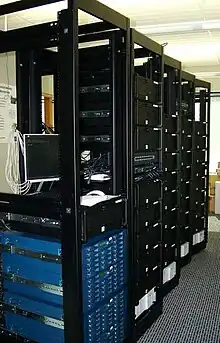gravitySimulator is a novel supercomputer that incorporates special-purpose GRAPE hardware to solve the gravitational n-body problem. It is housed in the Center for Computational Relativity and Gravitation (CCRG) at the Rochester Institute of Technology. It became operational in 2005.

The computer consists of 32 nodes, each of which contains a GRAPE-6A board ("mini-GRAPE") in a Peripheral Component Interconnect (PCI) slot.[1] The GRAPE boards use pipelines to compute pairwise forces between particles at a speed of 130 Gflops. The on-board memory of each GRAPE board can hold data for 128,000 particles, and by combining 32 of them in a cluster, a total of four million particles can be integrated, at sustained speeds of 4Tflops.[2]
gravitySimulator is used to study the dynamical evolution of galaxies and galactic nuclei.[3][4][5]
References
- ↑ S. Harfst et al. (2007), Performance analysis of direct N-body algorithms on special-purpose supercomputers, New Astronomy, 12, 357
- ↑ RIT's gravitySimulator Among the Fastest Archived 2013-01-26 at archive.today, HPCwire, July 15, 2005
- ↑ P. Berczik et al. (2005), Efficient Merger of Binary Supermassive Black Holes in Nonaxisymmetric Galaxies, Astrophys. J., 642, L21
- ↑ A. Gualandris and D. Merritt (2008), Ejection of Supermassive Black Holes from Galaxy Cores, Astrophys. J., 678, 780
- ↑ H. Perets et al. (2009), Dynamical evolution of the young stars in the Galactic center, arXiv:0903.2912
External links
- phiGRAPE, an N-body code optimized for GRAPE clusters
- How to build and use special purpose PC clusters in stellar dynamics